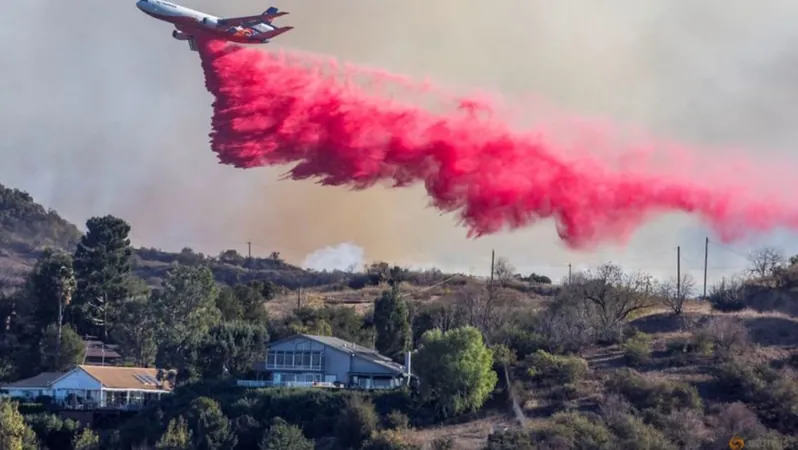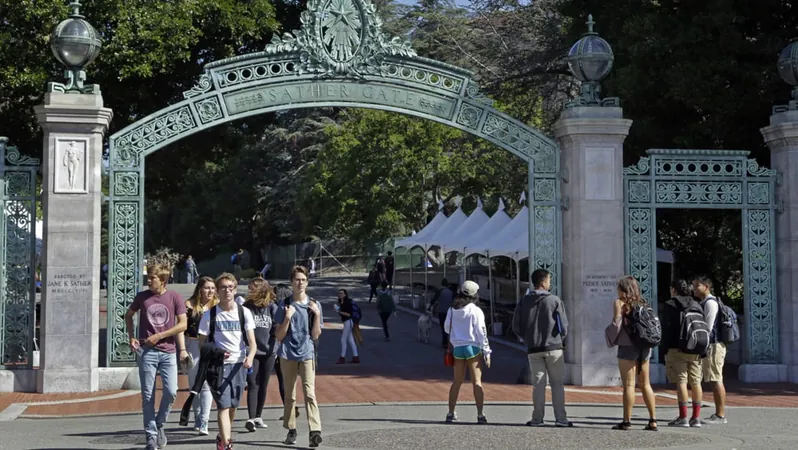
Aerial Assault Intensifies as LA Palisades Fire Threatens Communities
2025-01-12
Author: Wei Ling
Aerial Assault Intensifies as LA Palisades Fire Threatens Communities
In a harrowing battle against the ongoing Palisades Fire, aerial assaults have become crucial in preventing the blaze from spreading farther eastward. The fire has already made its way into the Mandeville Canyon neighborhood and now poses a significant threat to upscale Brentwood and the San Fernando Valley, inching dangerously close to the 405 freeway.
Worsening Conditions and Evacuations
With conditions worsening due to predicted Santa Ana winds, the National Weather Service has issued dire warnings for Los Angeles and Ventura counties. Meteorologists expect sustained winds reaching up to 48 km/h and gusts up to a staggering 112.6 km/h. NWS meteorologist Rose Schoenfeld remarked, "We're in a continued period of critical fire weather through Wednesday," with hopes for a slight moderation by Thursday.
Currently, evacuation orders affect about 153,000 residents, placing approximately 57,000 structures at risk. An additional 166,000 residents have been advised that they too may need to evacuate, according to Los Angeles County Sheriff Robert Luna.
Progress in Restoring Power
Amidst the chaos, there has been progress in restoring electrical power to neighborhoods, with Southern California Edison reporting that the number of customers without power has dropped from over half a million to about 50,000 within a few days.
Federal Response and Assistance
As the state grapples with what is being termed one of the worst fire clusters in Los Angeles history, President Joe Biden has stepped in, engaging local officials through phone consultations for updates and federal resource support. His recent major disaster declaration allows for federal assistance to flood into affected areas, with FEMA officials actively assisting residents in applying for aid at locations like the Pasadena Convention Center.
FEMA spokesperson Michael Hart emphasized that financial aid could commence within days, addressing urgent needs such as home repairs and replacements for lost food or medications. "We are looking to put initial funding in people's bank accounts to help them with those serious needs," Hart stated.
Rising Casualties and Damage
Tragically, the toll of the fires continues to rise, with at least 13 lives lost and 12,000 structures damaged or destroyed across the affected neighborhoods. Firefighters are still searching for the estimated 13 individuals who remain unaccounted for, and the outcome is expected to worsen as they begin detailed house-to-house evaluations.
Changing Fire Trajectory
Though Santa Ana winds lessened on Friday, the Palisades Fire's trajectory shifted towards the Pacific Ocean, marking it as the most devastating fire in the city's history. Before the recent flare-up, firefighting teams reported some containment progress, with the Palisades Fire at 11% contained and the Eaton Fire at 15%, according to Cal Fire.
Public Health and Community Impact
As conditions were declared a public health emergency due to toxic smoke, residents returning to charred neighborhoods were met with shocking devastation—homes reduced to ash, with only brick chimneys and burnt vehicles remaining. Kelly Foster, a Palisades resident, lamented, "This was a house that was loved," as she dug through remnants of her home that once stood proudly.
Economic Implications
The economic implications of this disaster are staggering, with estimates of damage reaching between $135 billion to $150 billion. Many residents fear that recovery efforts will disproportionately benefit wealthier communities, leaving them stranded without adequate support or insurance. California Insurance Commissioner Ricardo Lara has urged insurers to halt non-renewals of policies and extend grace periods for payments in light of the unprecedented disasters.
Maintaining Public Safety
Despite growing needs, officials are maintaining strict curfews to prevent criminal activities in the wake of the fires, as arrests for looting and other offenses have been reported. Sheriff Luna warned, "You go out there and you violate this curfew, you are going to spend time in jail."
Conclusion
As the situation develops, communities in Los Angeles remain in a state of high alert, relying on emergency responders and the collective effort of residents, officials, and federal agencies to navigate the overwhelming challenges posed by these catastrophic fires. The recovery may take weeks, if not months, and the scars left behind will haunt these neighborhoods for years to come.





 Brasil (PT)
Brasil (PT)
 Canada (EN)
Canada (EN)
 Chile (ES)
Chile (ES)
 Česko (CS)
Česko (CS)
 대한민국 (KO)
대한민국 (KO)
 España (ES)
España (ES)
 France (FR)
France (FR)
 Hong Kong (EN)
Hong Kong (EN)
 Italia (IT)
Italia (IT)
 日本 (JA)
日本 (JA)
 Magyarország (HU)
Magyarország (HU)
 Norge (NO)
Norge (NO)
 Polska (PL)
Polska (PL)
 Schweiz (DE)
Schweiz (DE)
 Singapore (EN)
Singapore (EN)
 Sverige (SV)
Sverige (SV)
 Suomi (FI)
Suomi (FI)
 Türkiye (TR)
Türkiye (TR)
 الإمارات العربية المتحدة (AR)
الإمارات العربية المتحدة (AR)